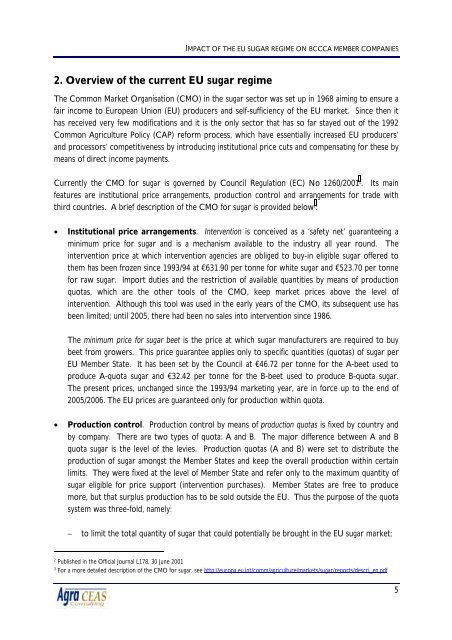2205 final report.pdf - Agra CEAS Consulting
2205 final report.pdf - Agra CEAS Consulting
2205 final report.pdf - Agra CEAS Consulting
Create successful ePaper yourself
Turn your PDF publications into a flip-book with our unique Google optimized e-Paper software.
IMPACT OF THE EU SUGAR REGIME ON BCCCA MEMBER COMPANIES<br />
2. Overview of the current EU sugar regime<br />
The Common Market Organisation (CMO) in the sugar sector was set up in 1968 aiming to ensure a<br />
fair income to European Union (EU) producers and self-sufficiency of the EU market. Since then it<br />
has received very few modifications and it is the only sector that has so far stayed out of the 1992<br />
Common Agriculture Policy (CAP) reform process, which have essentially increased EU producers’<br />
and processors’ competitiveness by introducing institutional price cuts and compensating for these by<br />
means of direct income payments.<br />
Currently the CMO for sugar is governed by Council Regulation (EC) No 1260/2001 2 . Its main<br />
features are institutional price arrangements, production control and arrangements for trade with<br />
third countries. A brief description of the CMO for sugar is provided below 3 :<br />
• Institutional price arrangements. Intervention is conceived as a ‘safety net’ guaranteeing a<br />
minimum price for sugar and is a mechanism available to the industry all year round. The<br />
intervention price at which intervention agencies are obliged to buy-in eligible sugar offered to<br />
them has been frozen since 1993/94 at €631.90 per tonne for white sugar and €523.70 per tonne<br />
for raw sugar. Import duties and the restriction of available quantities by means of production<br />
quotas, which are the other tools of the CMO, keep market prices above the level of<br />
intervention. Although this tool was used in the early years of the CMO, its subsequent use has<br />
been limited; until 2005, there had been no sales into intervention since 1986.<br />
The minimum price for sugar beet is the price at which sugar manufacturers are required to buy<br />
beet from growers. This price guarantee applies only to specific quantities (quotas) of sugar per<br />
EU Member State. It has been set by the Council at €46.72 per tonne for the A-beet used to<br />
produce A-quota sugar and €32.42 per tonne for the B-beet used to produce B-quota sugar.<br />
The present prices, unchanged since the 1993/94 marketing year, are in force up to the end of<br />
2005/2006. The EU prices are guaranteed only for production within quota.<br />
• Production control. Production control by means of production quotas is fixed by country and<br />
by company. There are two types of quota: A and B. The major difference between A and B<br />
quota sugar is the level of the levies. Production quotas (A and B) were set to distribute the<br />
production of sugar amongst the Member States and keep the overall production within certain<br />
limits. They were fixed at the level of Member State and refer only to the maximum quantity of<br />
sugar eligible for price support (intervention purchases). Member States are free to produce<br />
more, but that surplus production has to be sold outside the EU. Thus the purpose of the quota<br />
system was three-fold, namely:<br />
−<br />
to limit the total quantity of sugar that could potentially be brought in the EU sugar market;<br />
2<br />
Published in the Official Journal L178, 30 June 2001<br />
3<br />
For a more detailed description of the CMO for sugar, see http://europa.eu.int/comm/agriculture/markets/sugar/<strong>report</strong>s/descri_en.<strong>pdf</strong><br />
5













